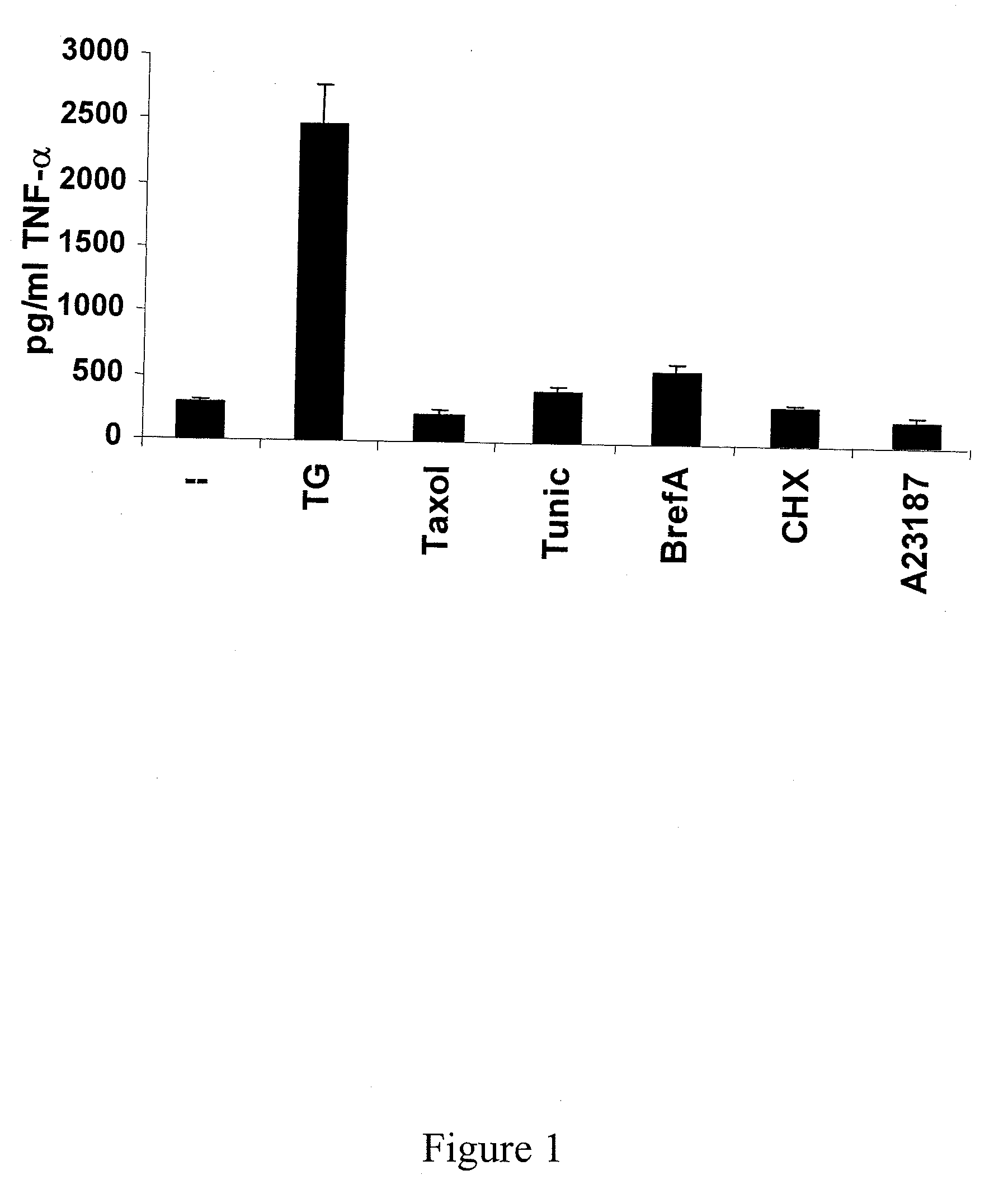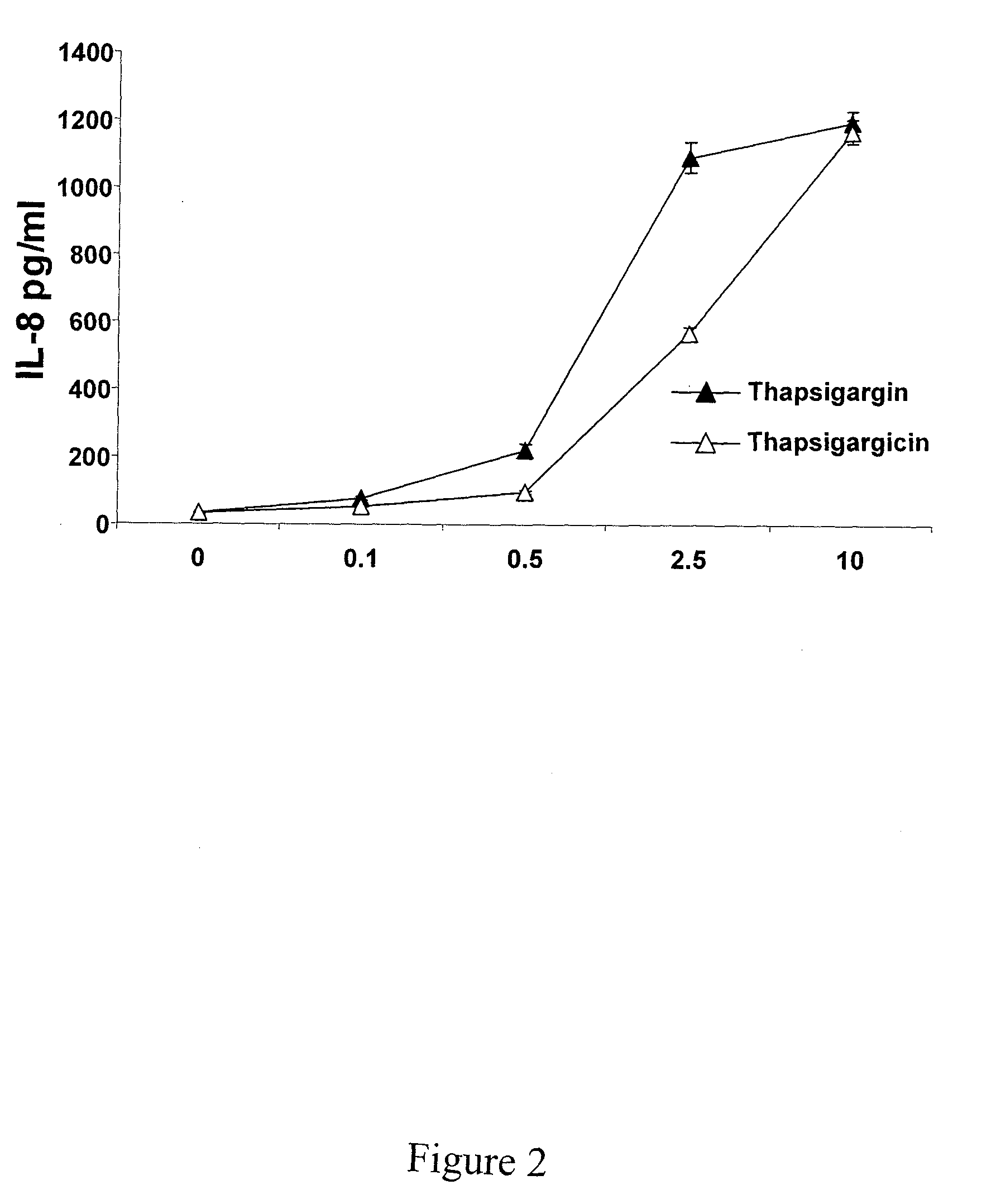Reagents and methods for cancer treatment and prevention
a technology of reagents and methods, applied in the field of cancer treatment and prevention, can solve the problems of not having the same theoretical drawback, affecting the treatment effect, and having only marginal or no effect in many other directions, and achieves the effects of minimal toxicity, minimal toxicity, and low chance of inducing antibodies to thapsigargin
- Summary
- Abstract
- Description
- Claims
- Application Information
AI Technical Summary
Benefits of technology
Problems solved by technology
Method used
Image
Examples
example i
Basic Laboratory Procedures
[0051]This example provides basic materials and methods that are used in Examples II-VII below. While these particular experiments utilized the specific compounds and techniques, other similar compounds and techniques are also capable of generating similar data.
[0052]Cell Lines
[0053]The human cervical epithelium cell line HeLa and the mouse B16-F10 melanoma were purchased from American TCC and maintained in Dulbecco's modified eagle's media [D-MEM (Cellgro®, Herndon Va.)] supplemented with 10% fetal bovine serum (Sigma-Aldrich, St. Louis, Mo.). All cell stress / death-related treatments described below were performed using HeLa cells in initial screens. The human promonocytic leukemia THP-1 (ATCC, Manassas Va.) and pro-macrophage MonoMac6 cells were utilized as the reporter antigen presenting cells utilized in this study. Ziegler-Heitbrock et al., “Establishment of a human cell line (Mono Mac 6) with characteristics of mature monocytes”Int. J. Cancer 41:456-...
example ii
[0068]Identification of a Thapsigargin-Sensitive Endogenous Danger Signal
[0069]A variety of different potential cell stress and cell death inducing agents were screened. The plant-derived thapsigargin toxin induced TNF-a secretion in a patient-derived cervical cancer cell line (HeLa) and was thus identified for use in the various anti-cancer embodiments described above. In contrast, other potential cellular stressors (i.e., for example, taxol, tunicamycin, brefledin A, cycloheximide, and calcimycin) were tested but did not induce immunostimulatory activity. (See FIG. 1).
[0070]Thapsigargin was also capable of activating an antigen presenting cell (APC) in a read-out system utilizing a monocytic cell line to secrete large amounts of the inflammatory cytokine tumor necrosis factor-α (TNF-α). (data not shown).
example iii
Thapsigargin-Induced Secretion of Cytokines
[0071]This example illustrates that thapsigargin treatment of cancer cells renders these cells immunostimulatory to antigen presenting cells (monocytes, macrophages, dendritic cells, etc.) which are activated to release cytokines. Although it is not necessary to understand the mechanism of an invention, it is believed that IL-12 plays a role in the development of cell-mediated immune responses (the type of immune response that may be necessary for the control of cancer and infection by intracellular pathogens).
[0072]A thapsigargin-related compound thapsigargicin (a less hydrophobic analog of thapsigargin) and thapsigargin activated a dose-dependent secretion of IL-8 from the monocyte cell line THP-1. (See FIG. 2). These data show that thapsigargin-related compounds are capable of activating a potent inflammatory reaction. Thapsigargin treatment also results in secretion of IL-12, IL-8, and TNF-α in a variety of patient-derived cancer lines....
PUM
| Property | Measurement | Unit |
|---|---|---|
| pH | aaaaa | aaaaa |
| resistance | aaaaa | aaaaa |
| drug resistance | aaaaa | aaaaa |
Abstract
Description
Claims
Application Information
 Login to View More
Login to View More - R&D
- Intellectual Property
- Life Sciences
- Materials
- Tech Scout
- Unparalleled Data Quality
- Higher Quality Content
- 60% Fewer Hallucinations
Browse by: Latest US Patents, China's latest patents, Technical Efficacy Thesaurus, Application Domain, Technology Topic, Popular Technical Reports.
© 2025 PatSnap. All rights reserved.Legal|Privacy policy|Modern Slavery Act Transparency Statement|Sitemap|About US| Contact US: help@patsnap.com



